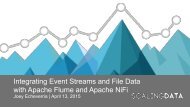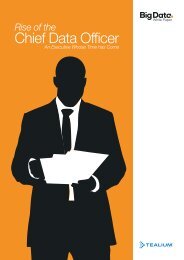NCDS-Summit-2013
NCDS-Summit-2013
NCDS-Summit-2013
Create successful ePaper yourself
Turn your PDF publications into a flip-book with our unique Google optimized e-Paper software.
Confidential - Under embargo until Jan-17th <strong>2013</strong>, 2PM EST<br />
Figure 3<br />
. .<br />
Pedigree 1<br />
. . .<br />
Pedigree 2<br />
. . .<br />
Pedigree 3<br />
. . .<br />
Figure 6. Re-identification of Sequenced Subjects<br />
through Surname Inferences Derived from Genealogy<br />
Databases. The figure shows three pedigrees, for<br />
which recovered surnames and Internet resources,<br />
including genealogy databases, were used to trace<br />
distant patrilineal relatives (marked as arrows in red<br />
patrilineal lines) to sequenced de-identified subjects<br />
(filled black squares) for re-identification. (From<br />
Gymrek et al., Science 339:321-324, <strong>2013</strong>. Reprinted<br />
with permission from AAAS).<br />
dividual advancement through publications and funding,<br />
rather than collective achievement through the<br />
dissemination of data (Howison and Herbsleb, 2011).<br />
The proprietary interests of health care systems likewise<br />
discourage data sharing. While federally funded researchers<br />
are encouraged to deposit genomic data into databases<br />
such as dbGaP, breaches in embargo periods (during which<br />
time external research groups cannot access an individual<br />
researcher’s data) can be detrimental to an academic career<br />
(Holden, 2009). Publications and database documentation<br />
rarely describe in detail the data collection, processing,<br />
and analysis steps in order to enable the reproduction<br />
of quantitative results to support published conclusions.<br />
A related challenge is that federal agency members, industry<br />
heads, scientific journal editors, and academic investigators<br />
have not partnered to develop the policies and<br />
infrastructure to guide and support the long-term maintenance<br />
of either primary data or secondary data sets. db-<br />
GaP is an exception, but as noted, it is not without problems,<br />
including issues related to data access and reuse.<br />
In terms of security, remote access to genomic data is often<br />
necessary but difficult to secure and protect. The incentives<br />
for maintaining high standards in privacy are often<br />
not clear or fully appreciated. In this regard, the distinction<br />
between the use of genomic data by health care providers<br />
and covered entities (under HIPAA regulation; US DHHS,<br />
http://www.hhs.gov/ocr/privacy) versus non-covered entities<br />
(under IRB regulation; US DHSS, http://www.hhs.<br />
gov/ohrp/assurances) often is not well understood, particularly<br />
among clinicians who are used to accessing PHI as<br />
part of their customary patient care.<br />
Even when privacy issues are fully understood, compliance<br />
and enforcement are difficult to maintain. For example,<br />
controlled access to data (i.e., authorized access,<br />
encryption) and a secure virtual workspace or network do<br />
not prevent data transfer away from the secure workspace<br />
(i.e., printing, downloading, email, etc.)—a common<br />
problem and a major source of security breach (Shoffner<br />
et al., <strong>2013</strong>).<br />
A related issue is that the owner of the data often determines<br />
the policies and procedures for privacy and security;<br />
however, if ownership is transferred, the new owners<br />
may not adopt the same policies and procedures. Analyses<br />
of costs, risks, and benefits of privacy policies and<br />
procedures are rarely considered before their implementation,<br />
but these are important considerations that factor<br />
strongly into any privacy and security plan (Shoffner et<br />
al., in press). A certain level of risk of a breach may be<br />
acceptable, for instance, if the cost, time, or impact on the<br />
speed of science is unacceptable or unreasonable with a<br />
suggested privacy and security plan.<br />
Data to Discovery: Genomes to Health / page 11




